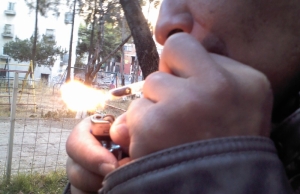Researcher Nets Grant to Combat Crack Cocaine Use in Mexico City
January 06, 2015 / by Eric Lindberg- Giving
- Research
Disturbed by new evidence that crack cocaine use may be reaching epidemic levels in Mexico City, researchers from the University of Southern California are testing a new strategy to fight back.
Led by Assistant Professor Alice Cepeda from the USC School of Social Work, the team will implement projection mapping, an emerging technology that projects two-dimensional images and animated text onto buildings and other large surfaces, to deliver health messages to hard-to-reach individuals who use crack.
“We are going into communities that are geographically, socially, and economically marginalized and reaching out to individuals who are not seeking out drug and health services and treatment and who are the most likely to be engaging in risk behaviors,” Cepeda said. “Our intent is to intervene and reduce harm before it gets out of control.”
One of only two USC researchers to ever receive a Grand Challenges Explorations grant from the Bill & Melinda Gates Foundation (Assistant Professor Beth Smith from the USC Division of Biokinesiology and Physical Therapy received a grant during the same round of funding), Cepeda will use the award to design engaging content she hopes will catch the eye of crack users and disrupt everyday risk behaviors in Iztapalapa, one of the poorest areas of Mexico City.
On the margins
As one of the city’s 16 delegaciónes, or boroughs, Iztapalapa features approximately 1.8 million residents and its colonias, or neighborhoods, are plagued by high crime rates, limited infrastructure and high population density.
“These are neighborhoods that are on the outskirts of Mexico City and don’t have the same services as other areas,” Cepeda said. “People always say that even police won’t enter many of the colonias there.”
For the past three years, however, the research team has canvassed those neighborhoods to interview crack cocaine users as part of a study led by USC School of Social Work Professor Avelardo Valdez. Findings have been alarming. High rates of sexual risk behaviors such as prostitution and trading sex for crack are being paired with risky practices such as sharing drug paraphernalia, exposing users to HIV and other infectious diseases.
Although the Mexican government provides universal access to antiretroviral therapy, testing and treatment services, individuals in Iztapalapa face significant barriers to receiving that assistance, primarily because outreach efforts rarely extend into their neighborhoods.
Reducing harm
When the Gates Foundation called for solutions to issues such as HIV that involved so-called behavioral nudges, Cepeda began envisioning a harm reduction approach to alleviate the negative consequences of crack cocaine use, rather than trying to jump immediately to prevention efforts.
“With this population, it’s hard to get users to desist from using from one day to the next,” she said. “The harm reduction component recognizes that these individuals are using, so let’s begin by giving them the tools and knowledge to reduce their behavioral risk.”
Collaborating with Elisabeth Mann, an associate professor with the USC School of Cinematic Arts, and partners at Mexico’s Instituto Nacional de Psiquiatría, she plans to create and project live action, text and graphic animations on buildings and other surfaces in several neighborhoods. These short and captivating messages will focus on behavioral nudges designed to promote healthy behaviors such as HIV testing and treatment, offer tips for negotiation of safer sex and drug use practices, and describe the risks of chronic crack use.
A team of promotores, or outreach workers, will also be on hand to engage individuals who appear interested in the projections to discuss the project, deliver more HIV-risk reduction information, and encourage testing and treatment. Researchers plan to distribute safer crack use kits to people who acknowledge that they smoke crack; these kits will include lip balm, hand wipes, condoms, brass metal screens and pipes that won’t burn the mouths or hands of users.
Evaluating the impact
Cepeda plans to interview approximately 50 people in the target neighborhoods prior to projecting the health messages, immediately after the project ends, and three months later to assess any changes in their knowledge of HIV and sexually transmitted diseases, their sexual risk, and their drug use and addiction severity.
If the project is successful, Cepeda can apply for a second round of funding from the foundation, up to $1 million, to expand her efforts. Moving quickly is critical, she said, before the problem becomes more difficult to address.
“Crack use may have reached epidemic levels in some Latin America countries,” she said. “Brazil has experienced really high rates of crack use. Our colleagues down there say the crack use phenomenon is beyond Mexico’s; that’s one of the reasons this study is so time-sensitive. Being able to intervene now may impede or stop the progression of this phenomenon.”
To reference the work of our faculty online, we ask that you directly quote their work where possible and attribute it to "FACULTY NAME, a professor in the USC Suzanne Dworak-Peck School of Social Work” (LINK: https://dworakpeck.usc.edu)
